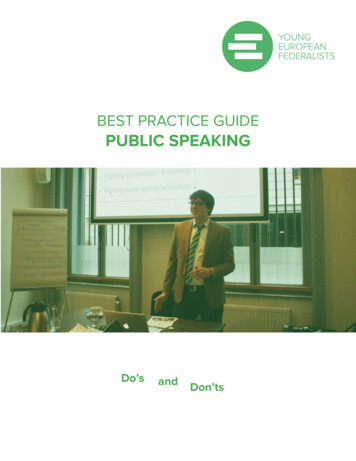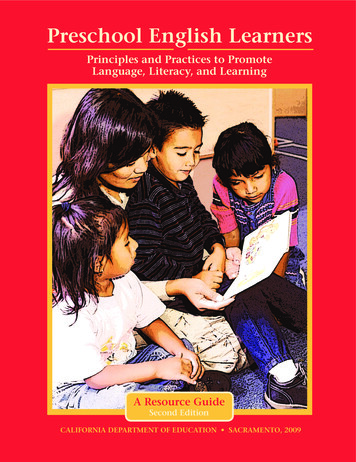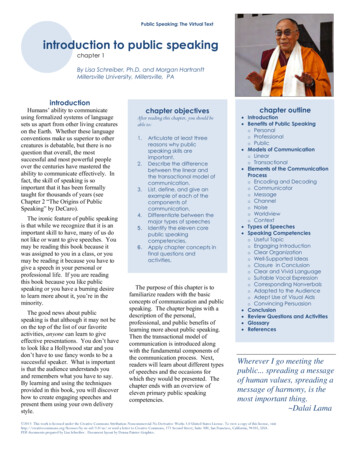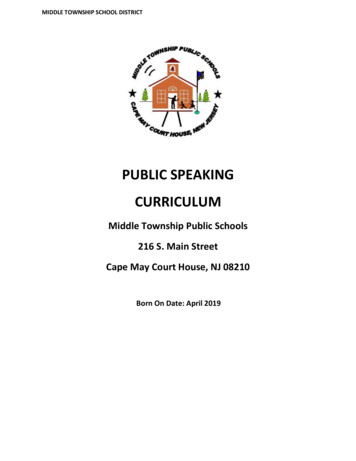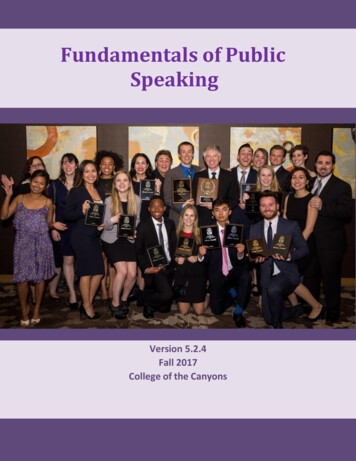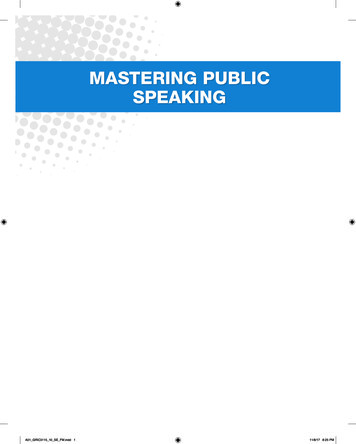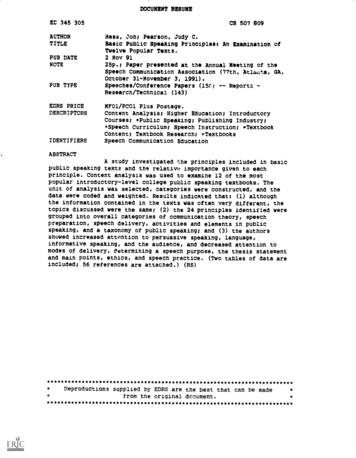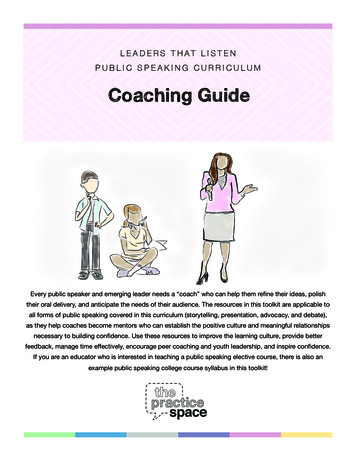
Transcription
LEADERS THAT LISTENPUBLIC SPEAKING CURRICULUML E A D E R S T H AT L I S T E N P U B L I C S P E A K I N G C U R R I C U L U MCoaching GuideEvery public speaker and emerging leader needs a “coach” who can help them refine their ideas, polishtheir oral delivery, and anticipate the needs of their audience. The resources in this toolkit are applicable toall forms of public speaking covered in this curriculum (storytelling, presentation, advocacy, and debate),as they help coaches become mentors who can establish the positive culture and meaningful relationshipsnecessary to building confidence. Use these resources to improve the learning culture, provide betterfeedback, manage time effectively, encourage peer coaching and youth leadership, and inspire confidence.If you are an educator who is interested in teaching a public speaking elective course, there is also anexample public speaking college course syllabus in this toolkit!
Why We Need Leaders That Listen:A Note from the AuthorAs a teacher and public speaking coach, I havealways been drawn to the quirkiest students.I love unexpected perspectives that make me think about an issuein a different way and inspire me to care about experiencesI never understood. Unfortunately, we are surrounded by imagesof leadership and models of public speaking dominated byexamples that are loud, angry, and driven by ego. Every day,I encounter students from as young as 7 all the way to adulthoodwho have beautiful voices and incredible stories but do not believethey are important. They have been taught that they aren’t leadersbecause they do not look, act, or sound like the people in power.It is important to have mentors and a community to help you havethe courage of your own convictions; just because you don’t lookor sound like everyone else doesn’t mean you don’t deserve tohave a voice. Our society needs leaders who know how to facilitatediverse perspectives, learn from different experiences, care abouthuman beings, and listen without an agenda. This curriculumis a starting point for educators, coaches, and emerging publicspeakers of all ages who want methods for communicating in away that is authentic and real, empowering their inner leader andencouraging diverse voices through inclusive education. Explorethe guides in any order and choose tools that best fit your needsand build your confidence. Gather inspiration and feel free to adaptas you develop your skills and the abilities of those you lead.AnnMarie D. Baines, PhD, Executive DirectorAbout the AuthorAs Founder and Executive Director of Bay Area non-profit, The Practice Space, AnnMarie Baines brings 20 years ofexperience coaching public speaking for youth and adults and currently teaches public speaking at UC Berkeley. As a Filipinaleader, Dr. Baines is deeply committed to equity, and was awarded a Deeper Learning Equity Fellowship. In prior work,Dr. Baines was a program officer at the George Lucas Educational Foundation, where she applied her expertise in curriculum,project-based learning, and professional development. She began her career as a high school special education teacher andutilizes the Universal Design for Learning framework. Dr. Baines received her PhD in Learning Sciences from University ofWashington, teaching credential from Boston Teacher Residency, and Master’s in Education Policy from Harvard GraduateSchool of Education.The Leaders That Listen curriculum is made possible by a grant from the William & Flora Hewlett Foundation. Special thanks to AngelaDeBarger, Sara Waters Design Group, Min Lee, Jessica Mironov, Rody Boonchouy, Lola Sims, Tashaka Merriweather, and Gillian Grisman.
COACHING GUIDETable of ContentsResource 1Coaching: Establishing and Sustaining a Culture of Talk.1Resource 2Conditions for Equitable Voice: What to Say and Do.3Resource 3Self-Assessment of Coaching Mindset and Skills.4Resource 4Coach Learning Plan.6Resource 5Trajectory of Speaker Skill Development.7Resource 6Example of Public Speaking College Course Syllabus.11Resource 710 Techniques to Promote Confidence and Early Success.20Resource 8Helping People Contribute: Facilitation Moves to Improve Communication.21Resource 9How to Coach Better Speaking Delivery.22Resource 10How to Coach Speech Writing.24Resource 11Do’s and Don’ts of Oral Feedback.26Resource 1212 Tips for Time Management.27Resource 13How to Run a Public Speaking Practice.29Resource 147 Steps for Peer Coaching and Student Leadership.30Resource 15How Friends and Families Can Coach Speakers.31Resource 16Before the Final: Inspiring Speaker Confidences.32
COACHING GUIDE: RESOURCE 1Coaching: Establishing and Sustaining a Culture of TalkHelping Leaders Battle Deficit MindsetsWork of Learning Disabilities”, changing disabling practicesrequires a constant battle against deeply embedded “culturalfacts”. While adults may adjust their mindsets to become moreinclusive and ability-oriented, youth can continue to reinforcethem, especially when the culture isn’t regularly tended andcultivated. The authors continue:Even if the teacher manages to treat every child as potentiallycapable, the children can hammer each other into negativestatus positions; and even if both teacher and children canresist dropping everyone into predefined categories, thechildren’s parents can take over, demanding more and moreboxes which specify the kinds of kids who do better thanothers. (McDermott et al., 2006, p. 15).Public speakers need reassurance that they are making progressand the subjective nature of communication skills and how ideasare perceived can lead to a great deal of insecurity. When peoplefeel insecure, they are more likely to criticize one another, competefor approval, and try to assert their dominance over others. On theflip side, people can also be their own worst enemies. Accordingto one high school public speaking student, “I actually need morehelp to escape my own limitations and reach past the labels Iput on myself.” As a coach, supporting their development meansinterrupting these tendencies and continuing to reinforce thevalues of diversity and inclusion.To feel capable enough to lead and speak, people need to firstfeel like they belong to a community that cares about them. Publicspeaking of any kind requires deep vulnerability and a willingnessto grow and take risks, which is not possible without a strongculture and facilitators who help maintain that culture. Instead of“teachers”, emerging public speakers need “coaches”, guides andmentors that foster the sense of safety, fun, and support they needas they embark on a journey to express their views and identities.Mindsets, perceptions of ability, and trust play a key role in settinga positive tone and establishing a strong culture of talk, wherepeople feel free to articulate diverse viewpoints. Coaching publicspeaking must begin with the assumption that every personis capable and the role of the coach and community is to helppeople express those abilities, reveal their strengths, and seekout potential. It is too easy to slip into the mindset that coachesmust fix mistakes and distractors like “umms” or fidgeting. Whilethis kind of technical work might be relevant later, the focus ofcoaching should be on getting to know each person, establishinga relationship, and understanding the intent of their message. Therelationship necessary to help develop a public speaker cannot bebuilt upon deficit thinking.What to Look For Over TimeBuilding a culture of talk can be a fragile process, which must bemodeled, revisited, reinforced, and assessed at regular intervals.Fortunately, there are many verbal and non-verbal indicators tolook for over time to anticipate any issues in advance. Someindicators include: Open vs. closed body language. Open body language lookslike: eyes up, engaged facials, attentive, sitting at the edgeof the seat, or eagerly listening. Closed body language lookslike: hunched shoulders, avoiding eye contact, facials that lookbothered or visibly upset, or head down. Direction of talk. It is good for talk to be directed mostly toeach other, as opposed to towards the teacher for approval. Distribution of talk. It is good for contributions to be distributedthroughout the group, as opposed to held primarily by a fewpeople.Barriers to an Inclusive CultureWhen working with a group or a classroom of students, sustaininga culture of talk goes beyond work with individuals. People arehardwired to rank one another and compare themselves to thepeople around them. As Stanford University’s Ray McDermott andcolleagues highlight in their 2006 research article, “The Cultural1
The Final Takeaway On-guard vs. Relaxed energy. Are people at ease? Or do theylook stiff, worried, and concerned? People don’t necessarilyneed to be talking all the time to indicate a supportive culture,but they should usually look relaxed. Draft thinking. When people are able to “think out loud” or takerisks and try out new ways of doing something, it is likely thatthe culture is supportive. Participation over time. Over time, there should be positivedevelopments in people’s ability to participate. Ideally, thismeans that a greater variety of people speak more often andwhen they do, their thoughts are more-developed, independentideas. Demonstration of care. A supportive culture is one wherepeople show that they care about one another through theiractions and words. Willingness to help each other improve. While this is related tocare, an inclusive culture is also one where people actually feelinvested in the performance of others. Instead of competing,they help coach one another and give helpful advice. Informal comments. Listening for the little off-hand commentspeople say in reaction to one another can be a strong indicatorof how positive or negative the culture is. Extended interactions. It is a good sign when people genuinelywant to spend time with one another. A positive culture is onewhere people want to interact beyond the learning setting duringtheir informal and social time.Coaches have an important responsibility to disrupt negativepatterns of behavior that lead to some people feeling excluded.To intervene when there are indicators of negative, restrictiveculture, it is always good to begin with relationship-building.Know your students and what makes them feel valued and don’tbe afraid to ask questions about what makes them feel happy,scared, or angry. Experiment heavily at the beginning by changingup groupings and having an especially wide range of types ofactivities (i.e. independent vs. group, silent vs. enthusiastic,physical vs. creative, prepared vs. spontaneous, performing inpairs vs. performing for the class). Collect evidence over timeabout how different people respond and repeat what goes well.More than anything, it is also important to realize that the coachcannot set the culture alone, nor can a coach take total creditwhen the culture is strong. Instead, an effective coach createsthe models, routines, and structures to help the group shape theculture in a way that supports everyone, and knows when to let goand allow the culture to evolve on its own.Instead of “teachers”, emerging publicspeakers need “coaches”, guides andmentors that foster the sense of safety,fun, and support they need as theyembark on a journey to express theirviews and identities.2
COACHING GUIDE: RESOURCE 2Conditions for Equitable Voice: What to Say and DoBuilding culture is a complex task, especially with the goal of creating a more equitablelearning environment.Establishing conditions for equitable voice means actively interrupting tendencies to put people down, and instead reinforce interactionsthat validate diverse contributions and help everyone fully participate and be powerful. It is important to reflect on your own perceptionsand assumptions about people in the room and be open-minded. Perceptions shape our words and our actions, which are also essential tosetting a tone for equity right from the beginning.What to Say.What to Do Frame your hopes for a positive, inclusive experience foreveryone.Co-determine norms and how people should treat each other.Communicate care and support.Be consistently fair and model the interactions you want.Give examples of how people can be themselves.Start with a wide range of activities.Say specifically how you hope people should participate andcontribute (not just that they should participate).Establish easy points of entry.Mention ways you hope people will take charge of the cultureover time (i.e. planning activities for everyone, decorating thespace, mentoring each other, taking on leadership roles).Balance structure with freedom.Validate early contributions from as many people as possible.Start getting to know people and deepen this knowledge overtime.Ask questions that make people add onto or reflect on thestatements of othersAssign groupings and change them oftenSuggest ways to get started with participation.Interrupt negative talk, but forgive easily.Don’t wait too long to check-in with questions andencouragement.Know when to leave people alone and let them be -- revisit later.Gradually say less over time, except to guide and reinforcepositive culture.Observe responses over time and make adjustments. 2020 The Practice Space10261 San Pablo Avenue, El Cerrito, CA 94530 www.practice-space.org admin@practice-space.orgThis work is licensed under the Creative Commons Attribution 3.0 Unported License.To view a copy of this license, visit http://creativecommons.org/licenses/by/3.0/ or send aletter to Creative Commons, PO Box 1866, Mountain View, CA 94042, USA.3
COACHING GUIDE: RESOURCE 3Self-Assessment of Coaching Mindset and SkillsCoaching public speaking begins with a mindset driven by four principles:1.Everyone is capable of expressing themselves;2.Coaching is about sharpening someone’s voice anduncovering someone’s best self;3.Coaches must rigorously hunt for undiscovered areas ofpotential; and4.Coaches help people own their voice and make moreintentional decisions about their speaking, even if the endproduct isn’t what they would do. To stay in this mindset, it isimportant not to be distracted by supposed norms of successor helping people please others. Start with what is importantto the student and help make ideas and positions moreprecise.Use this self-assessment to see where you are and how youmight improve. On the line next to each item, rate yourselffrom a scale of 1 to 5 (1: just emerging; 3: developing; 5:expert). This isn’t a quiz and the goal isn’t to get a perfectscore in every area. Instead, this will help you identifyspecific areas for your own growth and development.MindsetSkillsI genuinely believe that everyone can be an effective publicspeaker.Facilitation:When I coach, everyone is able to participate and bethemselves.I can set aside preconceived ideas about what a “good”public speaker is.I can manage large groups so everyone stays engaged andcan participate.I can avoid comparing students to each other and meet themwhere they are.I genuinely enjoy hearing what people have to say.I can facilitate small groups so that everyone can participateand feel productive.I am flexible in my thinking about how to help people bestrong speakers.I make sure that I don’t dominate interactions or make theexperience about me.I am open to learning from my students.Pedagogy:I can design experiences with multiple ways to interact andexpress thoughts.I am willing to take a completely different approach (evensomething I have never donebefore), if that’s what the student requires.I can give instructions and explain things clearly.I want students to push me to be a better coach, even if itrequires more time from me.I can balance different pedagogical approaches (i.e. lecture,groupwork, silent work).If a student doesn’t get it, I realize that there may besomething different I need to do.I can manage time effectively to help everyone accomplishtheir goals.I can handle negative criticism to adjust and improve.I can handle when things don’t go perfectly.I can adjust my approach on the spot.I adjust my own communication style and approach toenhance clarity and engagement.4
Guidance:Relationship-Building:I can give specific and helpful feedback.I use my knowledge of students to adjust and redesign futureapproaches and plans.I know how much feedback to give and when to give it.I can relate to my students and build strong relationships.I can assess where someone is developmentally and adjustto meet their needs.I can tell when what I think I mean doesn’t match how othersinterpret it.I can effectively read a student and determine what theyneed in a particular situation.I can listen without judgment or an agenda.I can help someone organize their thoughts and put theminto words. 2020 The Practice Space10261 San Pablo Avenue, El Cerrito, CA 94530 www.practice-space.org admin@practice-space.orgThis work is licensed under the Creative Commons Attribution 3.0 Unported License.To view a copy of this license, visit http://creativecommons.org/licenses/by/3.0/ or send aletter to Creative Commons, PO Box 1866, Mountain View, CA 94042, USA.5
CCOOAACCHHI INNGG GGUUI IDDEE: : RREESSOOUURRCCEE 140How Coachto CoachSpeechWritingLearningPlanImproving your skills as a coach means knowing your strengths and prioritizing your goals.Many facilitation-related skills take years to develop, and there is no substitute for sheer experience. That said, every coach, with no matterhow little or how much experience, has room to improve to better support the needs of emerging public speakers. People’s needs changeas well, so it is important to rethink and refine your planned approach to meet those needs. Beyond coaching skills and mindsets, culturebuilding may also be an area of focus. Fill out these columns to narrow your short and long-term goals, and rank their priority(use the back for more room!).As a coach, I want to beable to.I already feel confidentwith.In the short-term, I need tofocus on Over time, I gradually wantto . 2020 The Practice Space10261 San Pablo Avenue, El Cerrito, CA 94530 www.practice-space.org admin@practice-space.orgThis work is licensed under the Creative Commons Attribution 3.0 Unported License.To view a copy of this license, visit http://creativecommons.org/licenses/by/3.0/ or send aletter to Creative Commons, PO Box 1866, Mountain View, CA 94042, USA.6
COACHING GUIDE: RESOURCE 5Trajectory of Speaker Skill DevelopmentNote for Coaches and Teachers:Teaching communication skills requires a developmental approach. This chart offers a rough guide for where to start and how to progressover time. Youth and adults often follow different trajectories from one another, so this includes guidance on both. Of course, people arealways different and this description may not always fit your situation -- remember, this is not a fixed process! Use this as a guide and stayflexible and informed by the people in front of you. For more ideas, see activities later in this guide and in other guides in this curriculum.Youth TrajectoryPhase 1:BuildPersonalConnections.Beginning young speakers benefit from building personal connections.When designing activities, use prompts to unearth shared beliefs andinterests or discussions and share-outs to help students find what theyhave in common (in terms of working style, interests, goals, etc).Ideas: Try to include structuredsocial time, games, and time to shareinterests, expertise, or progresstowards goals.Phase 2:Initiate TeamCulture.After building personal connections, deepen the culture of the group.Have students come up with team names, mascots, and rituals thatthey will have as a group. Hold a discussion where students collectivelydefine what they see as ideal communication traits and how they mightrecognize when they’ve been achieved.Ideas: Early on, try student-ledroutines, including speakingwarm-ups such as stretches, vocalexercises, and tongue twisters.Phase 3:MakePersonalChoices.Students need to try out different ways of speaking and then makea choice about what suits them. Use demos or mini-speeches toexplore basics of speaking genres (narrative, persuasive, informative,interpersonal). Then, help students make choices about what format andstyle of speaking best fits them and their message.Ideas: Try short speaking drills topractice different genres using silly or“hot” topics that don’t require priorknowledge. For example, tell a storyabout one of three random words.Or, give students a paragraph of aspeech script to try delivering.Phase 4:IncreaseComfort.After students make choices about what style of speaking they want totry, start with low stakes experiences to help them feel like speaking ispossible. Over time, gradually:1) Increase speech length;2) Increase content difficulty;3) Reduce amount of prep time;4) Increase delivery demands;5) Increase audience size;6) Decrease audience familiarityIdeas: Have students collaboratewith a peer coach before speakingfor the class. For speech writing, usetemplates or post-its to scaffold theirbrainstorming.Phase 5:AccomplishPersonalProject.As students advance, have them take a deep dive into a personalproject (see examples in Resource 15 of the Storytelling Guide). Havethem choose a style to personally master (storytelling, issue speeches,podcasts, monologues). Refine their delivery techniques and personalstyle along the way.Ideas: Have students identifyspecific delivery goals and theirpreferred methods for feedback(written, oral, video). Have a classdiscussion on how to give qualityfeedback.7
Youth TrajectoryPhase 6:Collaborate toUse Voice inthe World.Take students beyond their own individual goals and take a deep diveinto a group project involving advocacy and persuasion. Focus on howto work together in a group to use their voice to improve the world,utilizing advanced spontaneous speaking and debate skills as well asfield research (see examples in Resource 15 of the Advocacy Guide).Ideas: Explicitly discuss studentleadership structures, including howto assign roles, decide their process,and create project task lists. If usingfield research, include class activitieswhere students practice interviewtechniques to gather field data.Phase 7:Lead andCoach Others.The most advanced phase for a public speaker is to be able to lead,coach, and mentor others. This can involve mentoring younger students,planning an event, creating a club or a team at their school, or eventeaching mini-lessons to the class on speaking.Ideas: Try creating simulationsto practice facilitation skills (seefacilitation skills in Resource 8 inthis Coaching Guide). Discuss howto identify and anticipate needsof others and generate ideas forhow to give “props” and celebratetheir classmates through positivefeedback.8
Adult TrajectoryPhase 1:Build SelfAwareness.Often, adults are not always aware of their own personal strengths orhave trouble telling their own stories. Coaches for adult public speakersshould help people:1) Articulate their personal core values and tell their personal stories;2) Set personal speaking goals and analyze everyday situations ofchallenge and triumph;3) Reflect on natural style and affirm personal strengthsIdeas: Use personal storytellingtemplates and have discussionsassessing where people feelcomfortable and where they don’t.Phase 2:ClarifyPurpose.After building self-awareness, it is important to have a clear purposebehind any talk. Coaches for adult public speakers should help people:1) Explore basics of speaking genres (narrative, persuasive, informative,interpersonal);2) Practice being flexible about using different speaking genres fordifferent situationsIdeas: Use simulations ofeveryday situations (i.e. interviews,presentations, panels) and practicestorytelling, persuasive speaking, andinformative speakingPhase 3:OrganizeIdeas.Organization is often a major challenge for emerging public speakers.Coaches should help adults:1) Clarify main ideas;2) Improve the sequencing and structure of ideas;3) Use powerful language that is meaningful and memorable toaudience;4) Be concise;5) Practice strong transitions;6) End with recaps.Ideas: Have the adult student talkthrough their ideas as you scribe andtake notes. Try having the studentwrite down each idea on a singlepost-it and then place them on theboard and group common ideastogether and order them in a waythat flows best.9
Adult TrajectoryPhase 4:InternalizeStrongDelivery.After working on content, focus on improving oral delivery. Coachesshould help students:1) Identify personal style or “color” (see Resource 11 in the PresentationGuide);2) Create habits around warming up breath support, voice, stance,enunciation, gestures, facials and eye contact;3) Build awareness of natural strengths and pinpoint distractions andtroublespots.Ideas: Try warm-ups in Resource9 of the Presentation Guide as wellas the checklist for using your bodyas a speaker in Resource 12 of thePresentation Guide.Phase 5:PrepareEffectively.After building a strong foundation, it helps to prepare for a specificsituation. If an adult speaker is preparing to give a talk, coaches should:1) Ask about objectives, event details, audience;2) Create outlines that state the “gist” of each point they want to make;3) Practice the sequence of ideas and transitions (if relevant);4) Practice how to “reset” themselves to maintain energy and endurancefor long talks.Ideas: Have the student practicemaking quick outlines with limitedtime or practice telling spontaneousstories with themes.Phase 6:Advocate andParticipateMore.Beyond preparing for a single situation, adult speakers can benefit fromtalking through everyday communication with a coach. Coaches shoulddiscuss:1) How to speak up for personal needs and interests;2) How to ask questions and listen to the needs of others;3) How to figure out areas of comfort and discomfort when participatingin conversations.Ideas: Help the student seek outspeaking opportunities for practiceand reflect on them together.Phase 7:Facilitateand MentorOthers.Like young speakers, the most advanced stage of public speaking isbeing able to mentor others. Adult speakers can do this by:1) Improving their questioning techniques;2) Helping others feel heard and listened to;3) Noticing when someone is not included;4) Giving others opportunities to lead;5) Providing actionable feedback; and6) Modeling strong communicationIdeas: Coaches can try simulationsfor people to practice facilitation,hold discussions of how to identifyand anticipate needs of others, andeven film simulations of coachingsessions to analyze and look attogether to find ways to improve. 2020 The Practice Space10261 San Pablo Avenue, El Cerrito, CA 94530 www.practice-space.org admin@practice-space.orgThis work is licensed under the Creative Commons Attribution 3.0 Unported License.To view a copy of this license, visit http://creativecommons.org/licenses/by/3.0/ or send aletter to Creative Commons, PO Box 1866, Mountain View, CA 94042, USA.10
COACHING GUIDE: RESOURCE 6Example of Public Speaking College Course SyllabusA Note to TeachersThis is an example of a college-level syllabus for a public speaking course taught at UCBerkeley. While the particulars of this class may not necessarily fit your situation, it isintended to spark potential ideas for what the flow of a formal public speaking class inschool might look like. This syllabus was designed with 6 hours of instruction time perweek and 35 students in the class, where none of the students had any experience withpublic speaking and took the class to gain confidence.11
FALL SYLLABUSTheater 5 001 – STD 001Department of Theater, Dance and Performance StudiesUniversity of California, BerkeleyPublic Speaking and Presentation Skills[Instructor]Course Section:M, W, F, 8am – 10am[Location]OH: By appointment or Fridays, 10-10:30 after classOVERVIEWThroughout this course we will explore the following: How can we authentically and creatively express our personal identities through different methods of oral communication? How can we improve our self-confidence, comfort with vulnerability, and sense of connection to others through public speaking? How do different genres of oral expression help strengthen our ability to use our voices to advocate, lead, and publicly engage?This course is designed to help students analyze and reflect on how they express themselves, connect with others, and use their voices inservice of improving the world around them. By exploring public speaking techniques in the context of a range of persuasive and creativestyles, students will find an entry point to effectively communicate what they care about. Throughout the course, students will have multipleopportunities to learn different techniques, apply them in practice sessions, receive quality coaching, and perform in a safe, supportiveenvironment. The course is designed so students gain experience with both prepared and spontaneous speaking, building self-awarenessabout their goals and needs as a pub
Coaching Guide Every public speaker and emerging leader needs a “coach” who can help them refine their ideas, polish their oral delivery, and anticipate the needs of their audience. The resources in this toolkit are applicable to all forms of public speaking covered in this curri

